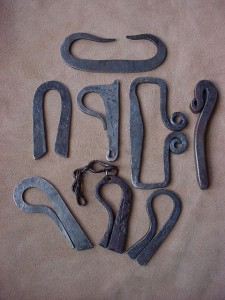Why did Matches lose their luster? When I was growing up in the 50’s and 60’s, camping and more particularly fire-starting was all about starting every fire with just one match. Whether starting a fire in the fireplace in the house or out at the campsite, the training was focused on the 1 match method. We got some decent tinder, and kindling in graduated sizes. With a match we had to carefully shield from the wind, that was the biggest threat in those days generally. In scouts we learned to make the “fuzz stick” which was very effective tinder, although not heard of so much these days. The only other real hassle with matches was if they got damp, the heads would fall apart and they were pretty much worthless. That was easily overcome with waterproof containers or dipping the tips in wax.
It seems we all get into either tech or ancient when it comes to fire starting, it wasn’t that long ago that flint and steel was the common method
European and Colonial fire starting
I have read the procurement logs of some early explorers and trappers, they would order fire steels by the dozens or hundreds. I have some steels patterned after Roman designs from medieval times, these are very quick and effective. With a properly made fire steel, a small piece of flint, and a little patch of char cloth, it is incredibly easy to start a fire. It is one of the easiest methods of fire starting there is.
What was the demise of flint and steel?
It was the wooden match A match is great because it contains all the elements needed to start a fire There is the striker and flame producer, the head of the match (chemical). The head is molded onto a wooden stick which provides a handle and dry tinder. If properly set up, one match is all you need to start most any fire.
History of Matches
The discovery of Phosphorus is credited to H. Brand of Hamburg. In 1669 he was trying to find a way to turn base metals into gold. In those days people tried anything, so it’s not too surprising what he did. Brand had saved up a vat of urine and allowed that to putrify, then he cooked it down to a paste, pretty gross to think about!! He heated the paste and condensed the vapors through water, giving him not gold but a white waxy substance that glowed in the dark, now you know how to make phosphorus, haha.
In 1680 Robert Boyle put phosphorus on paper and sulfur on a sliver of wood and found that it burst into flame when drawn across the paper. This never became popular since there was still not an effective way of producing phosphorus en mass.
It was not until 1827 that Robert Walker made practical matches, they did have one drawback, a very strong stinking odor, this was remedied by Charles Sauria in 1830 who used white phosphorous, however it’s side effect was that it was poisonous and caused defects in people who were exposed to it. Those who manufactured these matches, men, women and children got paid less than $1.25 a day, and got “Phossy jaw” a condition where the jaw cartilage disintegrated, leaving them, unable to speak and deformed. In 1910 Diamond match patented the worlds first non-poisonous match. This was so momentous that President Taft persuaded them to release the patent to the world for the sake of humanity, which they did. Diamond Match makes some 12 billion matches each year.
An alternate type of match was where the wood stick was replaced with a cardboard handle and they were stapled together in books called obviously, book matches, very convenient, but very susceptible to moisture problems. Initially these “book matches” were designed such that a person would light the whole book at once, a great fire starter, later the striking surface was placed on the outside and these matches were then used one at a time. When I was much younger I learned from an Australian guy how to start two fires from each book match, you just separate the cardboard layers in half and so you have 2 thin cardboard handles with half a head on each. It’s cool, try it!!
Wooden matches have really only one downfall, and that is keeping them dry out in the woods. If they get wet, they are worthless. They can easily be wax coated to solve that problem. Hurricane matches are just wooden sticks with a much longer head that is formulated to burn even with wind and moisture present.
Today the most common method of starting fire is the lighter. For the outdoorsman and survivalist, many other methods are studied and employed as a backup to lighters, metal matches (ferrocerium rods), magnesium bars, pistons, bow drill, etc.
Wooden matches are still a viable option. they are inexpensive, very effective, and easily available. With a lighter if the flint or valve mechanism breaks, its over, with a match if one fails just grab another. All your eggs are not in one basket.
Simple waterproofing can be done by dipping the end of the match in parrifin wax. (See our video on some options, coming shortly, check this link again later) This has the added benefit of enhanced burn.
It has been years since I started a fire with matches or even lit a stove, until just recently when a little bit of a taste for stuff from the “old days” hit me. I’ve had some fun reliving some of those experiences, and even gained a new appreciation for what not too long ago was a miracle. Don’t feel bad if you want to use matches, it’s still a good thing. Practice with everything you can.
 Until next time, this is Perry Peacock – Simplifying Survival
Until next time, this is Perry Peacock – Simplifying Survival




